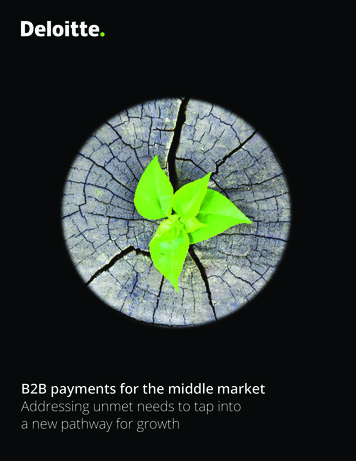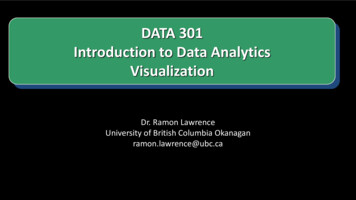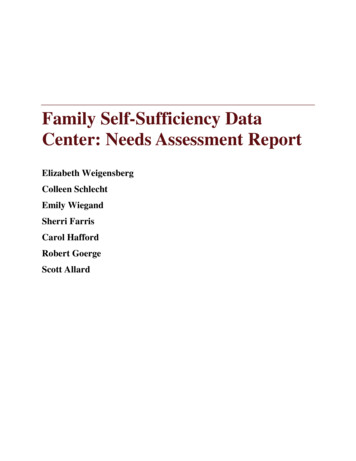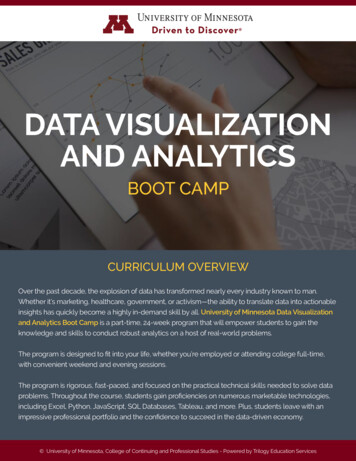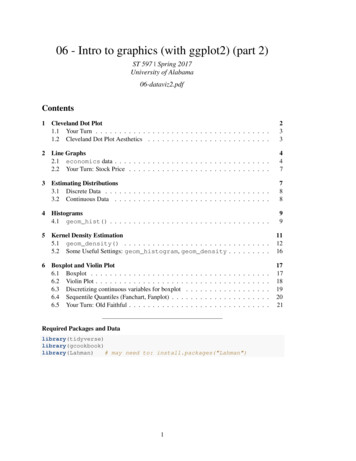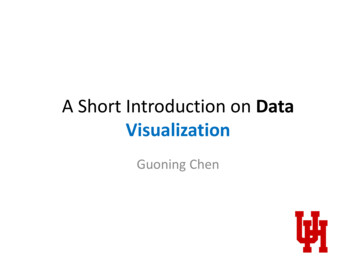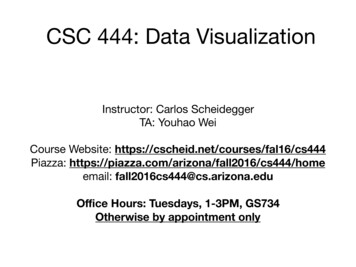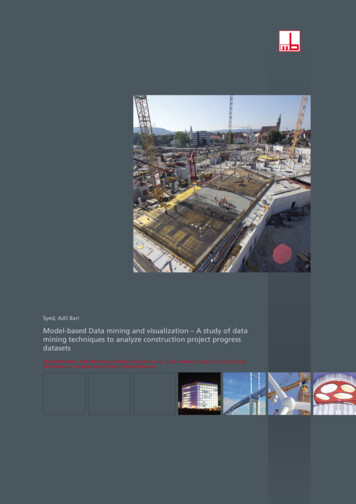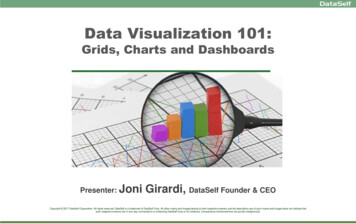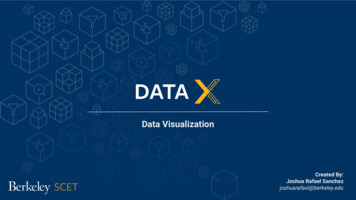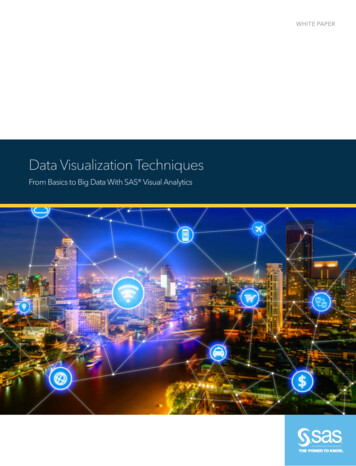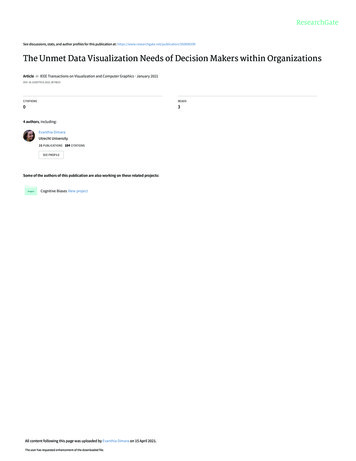
Transcription
See discussions, stats, and author profiles for this publication at: The Unmet Data Visualization Needs of Decision Makers within OrganizationsArticle in IEEE Transactions on Visualization and Computer Graphics · January 2021DOI: 10.1109/TVCG.2021.3074023CITATIONSREADS034 authors, including:Evanthia DimaraUtrecht University16 PUBLICATIONS 184 CITATIONSSEE PROFILESome of the authors of this publication are also working on these related projects:Cognitive Biases View projectAll content following this page was uploaded by Evanthia Dimara on 15 April 2021.The user has requested enhancement of the downloaded file.
AUTHORS’ VERSION, 2021. TO APPEAR IN IEEE TRANSACTIONS ON VISUALIZATION AND COMPUTER GRAPHICS1The Unmet Data Visualization Needs ofDecision Makers within OrganizationsEvanthia Dimara, Harry Zhang, Melanie Tory, and Steven FranconeriAbstract—When an organization chooses one course of action over alternatives, this task typically falls on a decision maker withrelevant knowledge, experience, and understanding of context. Decision makers rely on data analysis, which is either delegated toanalysts, or done on their own. Often the decision maker combines data, likely uncertain or incomplete, with non-formalized knowledgewithin a multi-objective problem space, weighing the recommendations of analysts within broader contexts and goals. As most pastresearch in visual analytics has focused on understanding the needs and challenges of data analysts, less is known about the tasksand challenges of organizational decision makers, and how visualization support tools might help. Here we characterize the decisionmaker as a domain expert, review relevant literature in management theories, and report the results of an empirical survey andinterviews with people who make organizational decisions. We identify challenges and opportunities for novel visualization tools,including trade-off overviews, scenario-based analysis, interrogation tools, flexible data input and collaboration support. Our findingsstress the need to expand visualization design beyond data analysis into tools for information management.Index Terms—Decision making, visualization, interview, survey, organizations, management, business intelligence.F1I NTRODUCTIONVISUALIZATION varies in its goals, from testing dataveracity or confirming a suspected pattern, to openended exploration in search of insight or enjoyment. Withinorganizations, often these processes serve an end goal ofmaking a decision that will affect the organization’s structure, processes, or outcomes. For example, a homeless shelter might need to decide which services might provide maximum benefit for an individual, while balancing resourcedistribution among many people. A university administrator might need to compare retirement plan offerings forfaculty and staff, while juggling an overwhelming list ofcosts and benefits to many parties.We argue that this decision making step has received toolittle attention in the visualization research literature. Acrossa survey and interviews of organizational decision makers,we identify challenges and opportunities for tools that canbetter support them.We summarize the challenges with an example abstracted from our interviews. Sam is the CEO of a cityconvention center, facing the decision of whether to makea large investment in a greener power plant. Her decision iscomplex. Some important factors are quantifiable after hiring outside experts, such as a consultant who can estimatethe tradeoff between initial capital costs against later savingsfrom higher efficiency and government tax incentives, orengineers who can estimate the greener system’s slower correction in interior temperature in response to rapid weatherchanges. But even these quantities carry uncertainties, orrely on sparse or unreliable data. Will that governmenttax incentive still exist after the next election? How muchwill the slower correction time upset our temporarily chilly E. Dimara is with Utrecht University and University of Konstanz.E-mail: evanthia.dimara@gmail.comH. Zhang and S. Franconeri are with Northwestern UniversityM. Tory is with Tableau Software.patrons, or temperature-sensitive catering operations? Otherfactors are difficult or impossible to quantify. How doesshe weigh financial factors against an improvement in theorganization’s reputation, or the abstract moral goal ofdecreasing negative environmental impacts? Sam does notfully trust the recommendations of the analysts because ofthis lack of context: To account for government tax incentive uncertainties, she dove into the financial data analysisherself, but gave up after wading through the consultant’sdozen disconnected spreadsheets.The goal of the present study is to identify how visualizations can be embedded within the complex framework oforganizational decision making (hereafter referred to simplyas decision making). We identify themes and challenges, aswell as opportunities for novel visualization tools to aiddecision makers like Sam. These opportunities stress theneed to expand visualization design beyond data analysisinto tools for information management, including tools thatfacilitate trade-off overviews, scenario-based analysis, interrogation, more flexible data input, and collaborative work.2R ELATED W ORKWe focus on decisions that influence the interpersonal,collaborative structures and processes of an organization(not just micro-decisions related to the decision-maker’sown personal workflow) and aim to characterize organizational decision makers as visualization users. To that end,we discuss works at the intersection of visualization anddecision making and then literature investigating the use ofvisualizations within organizations.2.1Visualization & Decision makingScholarly books on visualization emphasize that decisionmaking is the ultimate goal of data visualization [1], [2], [3],[4], [5], [6], while the effective support of those decisions has
AUTHORS’ VERSION, 2021. TO APPEAR IN IEEE TRANSACTIONS ON VISUALIZATION AND COMPUTER GRAPHICSA2TO WHAT EXTENT YOU CONSIDER "DECISION-MAKING" (i.e. the selection of a course of action over alternative actions) AS A PRIMARY TASK IN YOUR JOB?BDECISION MAKING - DM LEVELDECII makedecisions on a regular basis,mprimarily *across* multipledepartments or divisionsof my organization3I make some decisions withinmy organization, butnot on a regular basis.2I am not directly responsible formaking decisions, but my job is to suggestrecommended actions to decision-makers.15.000 16-201000-4.999Director11-15500-999Senior Manager6-103-5100-4990-210-242-9Junior ManagerNon-Entry Level itHealth Care0Government012Not at all. My roleI do not conductI conduct somedoes not involve data data analysis, but data analysis whenneeded, but notanalysis, and does not I do incorporateincorporate the work the work of data on a regular basis.of data-analystsanalysts in my work.CEDUCATIONPhDMscProfBScHS1PEOPLE I SUPERVISE 1000ORGANIZATIONTYPE201-1000For profit51-2001030 6051-6041-5031-4018-3025-99Entry Level E.AGEORGANIZATION SIZEExecutiveCEOTO WHAT EXTENT YOU CONSIDER "DATA ANALYSIS" AS A PRIMARY TASK IN YOUR JOB?DATA ANALYSIS - DA LEVEL122 decision makersDM LEVEL 142 data analystsDM LEVEL 2 ANDDA LEVEL 1** 13 excluded withDM,DA 2 (gray dots)EXPERIENCE YEARS 204I make decisions on a regular basis,primarily *within* a singledepartment or divisionsof my organizationNot at all. Apart from the microdecisions involved in my personalworkflow, my job is neither to makedecisions nor to suggest recommendedactions to decision-makers.JOB TITLEGENDERFemaleMaleNon-binaryN/AFINDINGS: WHAT COULD DECISION MAKERS NEED?3My primary jobis to conductdata analysis ona regular basis.flexibledata interfacesinterrogativetoolsscenario-based trade-off orientedsimulationsoverviewsFig. 1: A) Participants grouped as “decision makers” or “data analysts” based on their answers to the Decision Making(DM) and Data Analysis (DA) questions. B) Survey demographics. C) Emerging themes from our interview analysis.been identified as the core challenge of visual analytics [7].Decision-making is studied in domains such as psychology,economics, cognitive science and management, and eachdiscipline has its own understanding of decision-makingprocesses and how to study them. Yet visualization researchemphasizes building a unified cross-domain understandingof human decisions made with visualized data [8].Numerous visualization tools can potentially supportdecision making activities. General-purpose tools typicallysupport any multi-attribute choice task [9] through displayssuch as decision trees [10], interactive querying [11] ormore targeted solutions that allow users to express attributeimportance and visually combine attributes into aggregatedscores [12], [13], [14]. More sophisticated solutions mitigatedecision biases through algorithmic support; for example,to assist a credit analyst to rank qualified customers fora loan without discriminating against female customers[15]. Domain-specific visualizations are tailored to decisionmaking in applications such as epidemiological research[16], finance [17] or urban planning [18].While these systems likely contribute to data-informeddecisions, they focus on supporting data analysis stepsrather than decision mechanics. Most domain-specific designs are based on iterative development with data analystusers. However, data analysts report that senior decisionmakers often ignore their analysis unless it is oversimplified[19]. Most evaluations rely solely on visual analytic tasks(e.g., identify a correlation) rather than decision tasks [9].Yet, empirical research has shown evidence that users whosuccessfully complete visual analytic tasks can still fail onan almost identical task that is framed as a decision [20].A reason why visualization research lacks an explicit tieto decision making could be the lack of relevant foundationsin visualization literature. Although uncertainty researchsuggests that decision frameworks are essential for achieving realism and control [21], the visualization literatureprovides very few comprehensive frameworks that help usunderstand how humans make decisions over visualizeddata [8], [22], [23] and even fewer evaluation methodologiesand metrics to assess their effectiveness [9], [24].Notably, the few studies that do assess decisions concerncases of narrow complexity [25], such as binary decisiontasks [23], [26]. Here we attempt to understand morecomplex forms of decision making [27] by studying itsoperational perspective within organizations.2.2Visualization & Organizational ContextNumerous studies have investigated the use of visualization within organizational contexts. Most surveyed or interviewed professional data analysts about their data analysisworkflow and problems [19], [28], [29], [30], [31], oftentargeting specific analysis challenges such as the role ofexploratory analysis [32], [33], provenance [34], uncertainty[35], or big data [36]. Other works analyzed artifacts circulated within organizations, including visualizations [37],dashboards [38], or analyses of the features of commercialvisualization software [30]. This corpus of “in the wild”observations have identified critical challenges for visualanalytic tools, including demands to support statistical rigor(e.g., formal hypothesis testing, confidence intervals, normalization baselines) [29], [30], [36], data collection rigor(e.g., data cleaning and shaping) [29], [32], provenance [19],[32], [36], uncertainty exploitation [35], and audiences otherthan professional analysts, such as dashboard users [38].Common to all these studies is their choice of target user:the data analyst. Data analysts are typically characterized aspeople whose primary job function is to answer questionswith data [29], [32], [35], [36]. End products of their analysismay (or may not) support decision makers [35]. Unfortunately, this focus on analysts means that decision makersare currently understood incidentally and through the lensof their subordinate data analysts. Analysts have describeddecision makers as uncertainty-averse people [35] who donot use visualizations unless they display oversimplifiedinformation and gross trends [19], [37], noting that thecultures of analysis and decision making might not alwaysagree on a visual language [37].
AUTHORS’ VERSION, 2021. TO APPEAR IN IEEE TRANSACTIONS ON VISUALIZATION AND COMPUTER GRAPHICS3O RGANIZATIONAL D ECISION M AKINGTo understand decision making with data within a complexorganizational context, we briefly review critical ideas fromthe field of organizational theory.3.1Roles and Rules in Organizations3the typical quantitative optimization problems during technical decisions. They often ask: who are the stakeholdersinvolved in this problem? How influential are they? Howimportant are their demands? What are their individualgoals and how do those align with the organizational goal?Have they communicated with other parts of the organization? What are the unsolved problems and unused solutionswe currently have? What are our competitors’ decisions?As the roles, tasks and processes greatly differ betweendecision makers and data analysts, the visualization toolneeds of decisions makers likely differ drastically from thefeatures that help data analysts with data processing, analysis and presentation. This leads to our research question:Who are the organizational decision makers and what are theirdata visualization needs? We seek answers to this questionempirically using a survey (Section 4) and interviews (Sections 5 and 6).Organizations are social systems established to make decisions. Modern organizational research recognizes that complex decision making can easily overwhelm the capacityof any individual [39], [40]. Organization theory draws onsociology, economics, political science and psychology toprofi
Index Terms—Decision making, visualization, interview, survey, organizations, management, business . Participants grouped as “decision makers” or “data analysts” based on their answers to the Decision Making (DM) and Data Analysis (DA) questions. B) Survey demographics. C) Emerging themes from our interview analysis. been identified as the core challenge of visual analytics [7 .
